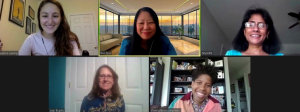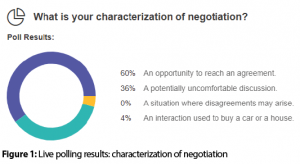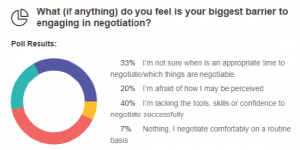Skills and Strategies for Successful Negotiation

”Skills and Strategies for Successful Negotiation,” a panel session at the 2020 Women in Statistics and Data Science Conference, featured Kelly H. Zou (top middle), Shanthi Sethuraman (top right), Lori Evarts (bottom left), and Emma Benn (bottom right) and was moderated by Jessica Lavery (top left).
A panel session titled “Skills and Strategies for Successful Negotiation,” moderated by Jessica Lavery at the 2020 Women in Statistics and Data Science Conference, featured Kelly H. Zou, Shanthi Sethuraman, Lori Evarts, and Emma Benn. The panelists shared their negotiation experiences from academia and industry and discussed strategies for navigating negotiation.
To start the session, the panelists polled the audience members to find out how they would characterize negotiation. Sixty percent viewed negotiation as an opportunity to reach an agreement, 36 percent as a potentially uncomfortable discussion, and 4 percent as an interaction for a transaction (e.g., buying a car or house). The panelists then asked what (if anything) audience members thought was their biggest barrier to engaging in negotiation. Results were split across lacking the tools, skills, or confidence to negotiate successfully (40 percent); not being sure when is an appropriate time to negotiate/which things are negotiable (33 percent); and being afraid of how they may be perceived (20 percent), with only a small percentage of attendees responding that they don’t feel they have barriers to engaging in negotiation (7 percent).
Emma Benn is an associate professor in the Center for Biostatistics and department of population health science and policy and the founding director of the Center for Scientific Diversity at the Icahn School of Medicine at Mount Sinai.
Lori Evarts is an assistant professor and the director of graduate studies of the Public Health Leadership Program at the UNC Gillings School of Global Public Health.
Shanthi Sethuraman is a senior director of global statistical sciences at Eli Lilly and Company.
Kelly Zou is PStat accredited and the head of medical analytics and real-world evidence
at Viatris.
Opportunities for Negotiation
A core theme of the session was that negotiation is not a one-off event that is finished once you accept a job. Across academia and industry, the panelists highlighted the need to be able to negotiate for resources, including salary support, flexible working arrangements, and promotions for students and full-time employees in addition to themselves on an ongoing basis. These negotiations regularly occur with other individuals and units of your organization or with external parties.
Statisticians and data scientists often need to negotiate with nonstatisticians to implement a particular study design or statistical methodology that is acceptable to both the analyst and the other party. Additionally, when working to write scientific publications with others, authorship is something that can and should be negotiated at the onset.
Skills and Strategies for Navigating a Negotiation
As opposed to being a competition, negotiations can be approached as opportunities to reach an agreement. Kelly Zou made an analogy for negotiations as optimization problems, in which there are limited resources and negotiations are necessary to allocate those resources in a way that is optimal for both sides.
Preparing for a Negotiation
Step one for any negotiation is to do your homework. Lori Evarts noted, “If it’s important enough to negotiate on, then it’s important enough to go prepared.” For example, there are important questions to be answered based on the goals of the negotiation. What do you need to get out of the interaction? What is the minimum you are willing to walk away with? This will help guide where to compromise and where to stand firm. It’s also important to understand what is important to the other party and why, and then figure out how to work with that person so you both gain something, even if it’s not everything you want. Think about how what you want will help (or at least not get in the way of) what the other party is seeking.
The importance of interpersonal relationships cannot be overstated. Identify the key stakeholders in the other party and work to build a relationship with them before and during the negotiation. Emma Benn referenced a recent negotiation in which she needed to know sports history to make a personal connection and develop a rapport with the person she was negotiating with. Don’t be afraid to go outside the box to make a personal connection.
It’s important to know yourself and how you might react when under pressure. Resources for finding this out include Meyer’s-Briggs Type Inventory (MBTI) and CliftonStrengths (formerly StrengthsFinder). Knowing your preferences and skills along with your potential weak spots ahead of time will help you prepare.
Practice, practice, practice! Evarts suggested rehearsing the conversation with another person, particularly a person who knows who you will be negotiating with so they can get into character and provide a realistic sounding board.
Presenting Your Argument
Going into a negotiation, it’s important to prioritize your ask. Zou referenced the pyramid principle, in which the top of the pyramid represents what you are trying to achieve. Below the top triangle, the remaining three pieces of the pyramid are the supporting arguments, or the reasons you are trying to achieve that goal, listed in order of importance. For example, if you are negotiating for increased computing resources, the top of the pyramid would be the goal: increased computing resources. The bottom portions of the pyramid could be: (1) data sets are becoming increasingly large; (2) parallel computing will speed up analyses; and (3) multiple users need to access the data at the same time. The point is to start with what you want to ask for, and then transition to the supporting evidence and reiterate the ask at the end.
Communication can shape the negotiation experience. With the pyramid principle, it is important to frame the supporting arguments in terms of how your goal helps the other party, using language such as, “If we have multiple users accessing the parallel computing systems to analyze large and complex data sets, your team will have results quicker and be able to publish more manuscripts this year.”
Shanthi Sethuraman referenced Jerry McGuire’s well-known quote, “Help me help you,” where the emphasis is on framing the negotiation as a team effort. “We” are engaging in a negotiation, rather than “I” am trying to get what I want out of this situation. To use welcoming and inclusive language, try to avoid saying, “My team needs …” or “I need … .” Instead, say, “What can we do here …” Your ask should be framed in a way that allows the other party to think they are getting what they want, too.
When thinking about how to frame your case, keep in mind the end user and what they need. For example, this could mean patients need a drug to get on the market sooner to improve their health. Acknowledging that you are potentially negotiating on behalf of a larger community can inform how you frame your position.
Closing the Deal
Be persistent. Not all negotiations will be solved in a single sitting. Make use of emails, calls, and video conferencing to ensure the other party is engaged and on board.
Last, Sethuraman emphasized not being afraid to ask to continue the conversation at a later date so you can further consider the other party’s perspective and needs. When both parties have had a chance to take some time away from the negotiation, it can be easier to be objective and work through the negotiation more smoothly.
Beyond Skills and Strategies: Contending with Barriers to Negotiation
Despite being trained in strategies for mastering negotiation, there are frequently systemic barriers that preclude people from successfully negotiating in the workplace. Such barriers often disproportionately affect people from underrepresented groups, including women; those classified as Black, indigenous, and people of color (BIPOC); people who identify as gender nonconforming and/or LGBTQ+; and non-US citizens whose visas are tied to their employment.
While there is no single way to universally overcome these systemic issues, Benn suggested pointing out biases directly. Given the current climate of racial injustices among other inequities, there is heightened awareness of how to be inclusive, providing an opportunity to speak up when this is occurring. This may be something you feel comfortable doing, or it may be a situation in which you ask for support from a colleague.
Support from colleagues and mentors can also come in the form of bringing someone into the negotiation for you. This uses the power and privilege another person may have that you do not, whether it’s based on their position, gender, race, or other characteristic. Importantly, there is a role and responsibility for people who are being heard in negotiations to pull up a metaphorical chair that their colleagues also have a seat at the table.
Editor’s note: The views expressed here are the authors’ and do not necessarily represent those of their employers.
Further Reading
Bennett, L. Michelle, Howard Gadlin, and Christophe Marchand. 2010. Collaboration and team science: A field guide. Bethesda, MD: National Institutes of Health
Golbeck, Amanda L., Ingram Olkin, and Yulia R. Gel (Editors). 2015. Leadership and women in statistics. New York, NY: Chapman and Hall.
Hughes, Jonathan, and Danny Ertel. 2020. What’s your negotiation strategy? Harvard Business Review.
Jeong, Martha, Julia A. Minson, Mike Yeomans, and Francesca Gino. 2019. Research: Being nice in a negotiation can backfire. Harvard Business Review.
Lencioni, Patrick. 2002. The five dysfunctions of a team. Hoboken, NJ: Wiley.
Zelnick, Leila. 2015. Negotiating a statistical career, part 1. Amstat News 455:16–17.
Zelnick, Leila. 2015. Negotiating a statistical career, part 2. Amstat News 456:20–21.



















